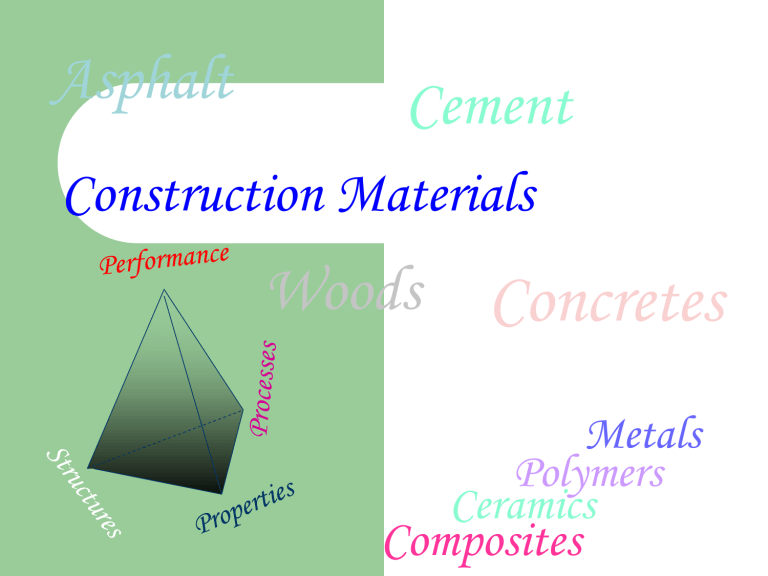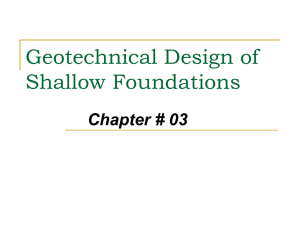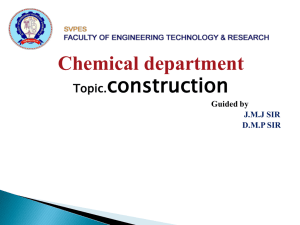File - DIV-A

Asphalt
Cement
Construction Materials
Woods Concretes
Metals
Polymers
Ceramics
Composites
Sand
It is the form of Silica .It is formed by decomposition of sandstones due to various weathering effects.
Fine minerals
The order of 0.1 to 1.0 mm diameter
Fill voids between the coarser aggregate
Types of Sand
1) Natural Sand – obtained from pits, shores, riverbeds seabed's…
2) Artificial Sand – obtained from crushing of stones.
Sand
Types of Sand (depending on fineness)
1) Coarse Sand – retaining on sieve 4.75 mm
2) Fine Sand – passing through sieve 4.75 mm
Uses
1) PCC, RCC, PSC
2) Cement mortar, Lime Mortar
3) Coarse Sand - plaster on Ex. Wall, Fine Sand – Plastering on
Internal Wall
4) Below flooring material
5) In filtration plant.
STONE
Cheapest, Durable and obtained from ROCK
Properly dressed and shaped before it is used.
Classification of Rocks
1) Geological – Igneous Rock, Sedimentary & Metamorphic
2) Physical – Stratified, un-stratified and Laminated.
3) Chemical – Siliceous, argillaceous, calcareous
4) Hardness of Stone - Very hard, hard, medium, soft
Uses of Stone
•Marble
•Slate
181
•Marble - Exterior
Application
182
•Slate Flooring
•Limestone with Granite
•Granite Material
•Polished Surface
•Rough Texture
Uses of Stone
Foundation, roofs floors, railway ballast, road metal.
Stone Blocks – Wall, Foundation,
Ornamental Facial work.
Slate – Roofing & Flooring
Lime Stone Slabs – Flooring, paving and roofing
Granite – bridge abutment, piers, flooring, kitchen otta, steps, table top etc…..
Marble – floors, tiles,
Ornamental Facial work.
STEEL
Steel is an intermediate form between Cast Iron and Wrought iron.
Steel are highly elastic, ductile, malleable, forgeable, weldable.
Grades of Steel –
Fe250, Fe415, Fe500
Fe = ferrous metal
Number = Yield stress in N/mm²
STEEL
Cast iron is iron or a ferrous alloy which has been heated until it liquefies, and is then poured into a mould to solidify.
Wrought iron is an iron alloy with a very low carbon (0.1 to 0.25) content in contrast to cast iron, and has fibrous inclusions, known as slag. Wrought iron is tough, malleable, ductile and easily welded.
Malleable is a material's ability to deform under compressive stress.
Classification of STEEL
Mild Steel -
Used as structural and
Non-Structural Steel, in form of
I, C, L, round, flat shapes.
It is Fe 250 as yield strength is 250 N/mm²
Tor Steel – used in RCC work,
It has low ductility and low bend ability.
It is Fe 415 & Fe 500 (yield stress)
High Tensile Steel – usually in form of WIRES of high tensile strength (tendon)
Used in prestress concrete.
1500 to 2350 N/mm² (Ultimate stress)
Mild Steel High Tensile steel
Tor Steel
Uses of Steel
Structural member in trusses, beams
Non Structural components for grills, stairs, windows, doors etc ….
Steel Tanks, Steel Pipes.
TOR steel in RCC member.
Tendons in PSC.
Corrugated sheets as roof covering
Mild Steel in manufacture of tools, equipments, towers, machine parts etc….
CONCRETE
(CEMENT + Fine Aggregate+ Coarse Aggregate
+ WATER)
PROPORTION ( 1:2:4), (1:3:6), (1:4:8)
GRADE M15, M20, M25……. And so on……
M- Mix Number – Compressive strength after 28 days in N/mm²
(A cementation reaction between water and the mineral in cement provide a strong matrix and good compressive strength)
Common construction material
Strong hard but brittle
Universal Testing Machine
Concrete Types
(PCC) Plain Cement Concrete
(RCC) Reinforced Cement Concrete
(PC) Precast Concrete
(PSC) Prestress Concrete
Types of Concrete
PCC – (cement + FA+ CA +Water)
Strong in compression and weak in tension
Hard and Durable
Manufacturing – Hand mixing or Machine Mixing.
USES – a) Foundation masonry, base of foundation.
b) Gravity Dam and Retaining Wall c) Below Flooring.
d) Leveling work over PLINTH.
Types of Concrete
RCC - ({Cement + Sand+ CA +Water} this mixture is Reinforced in STEEL)
Strong in compression and tension
Hard, Durable and bear all types of stresses.
R/f may be MILD STEEL Or TOR STEEL BAR.
Minimum Grade used is M20.
Manufactured on site may be Hand mixing or Machine Mixing.
USES
– a) Construction of multi storied buildings.
b) Road pavement.
c) Water tanks, bridges, concrete pipes.
d) Concreting of beams, columns, slabs, footing etc.
Cement
Sand
Aggregate
Water
Steel
R.C.C.
Concrete
Advantages of R.C.C.
a) Highly durable, Fire-resisting.
b) Monolithic character provides rigidity to structure.
c) Fluidity of concrete and flexibility of Reinforcement make it possible to mould into various shapes.
d) Cost of maintenance is negligible.
PRECAST CONCRETE (P.C.)
Casted in Separate form and then placed.
Casted in casting yard or on building site.
After casting, transported and placed in position by cranes.
PC units are –
1) Hollow concrete blocks
2) Tiles
3) Pipes
4) Roof Slabs
5) Electric Poles
6) Stair Case
7) Rail Sleepers
Uses Of P.C
Casting structural Elements like BEAMS,
COLUMS, SLABS, WATER TANKS, GIRDERS,
FRAMES, TRUSSES, SEPTIC TANKS,
WATERSUPPLY AND DRAINAGE PIPE, FENCING
POST, ELECTRIC POLES, CAISSIONS, TRAFFIC
BARRIERS, ROAD DIVIDERS, CONRETE PILES,
BRIDGE PIERS ETC………
Manufacturing-
(Reinforcement – Mould – Concreting )
Advantages-
Mould can be reused when production is in bulk
Better quality control as production is in factory
Smooth surface may be achieved and plastering may be avoided.
Precast Concrete Examples
PreStress Concrete.
Def:Concrete in which reinforcing steel bars/tendons are stretched and anchored to compress it and thus increase its resistance to stress.
Methods –
A) Pre-tensioning
B) Post-tensioning
Pre-tensioning
Steel reinforcement is first tensioned with hydraulic jack and then concreting is done and harden for 28 days.
Used for LONG SPANs.
Higher tensile strength is obtained.
Post-tensioning
Steel reinforcement is enclosed in ducts or metal sheets, concreting is done and harden for 28 days, then these steel reinforcements are tensioned with the help of hydraulic jack and anchored.
Used for LONG SPANs
Higher tensile strength is obtained.
Uses of PSC
PSC girders in bridges.
Railway Sleepers
Electric pole
Beams of large span
Pile foundation
Slabs
•Pile for foundation
Advantages
Size of structural member is reduced
Members can resist shocks, vibration, impact
Mostly high quality material is used.
STRUCTURAL COMPONENTS
STRUCTURE OF BUILDING IS DIVIDED IN
Two CATEGORIES-
1) Superstructure – (above GS)
2) Substructure – (Below GL)
Components of Substructure: a) Foundation b) Plinth c) Damp proof Course (DPC)
Foundation
Total Load of SUPERSTRUCTURE is transmitted to the FOUNDATION BED via SUBSTRUCTURE.
Def .:- ‘Structure which supports the superstructure’
Transmitting media – usually made up of RCC
Foundation Bed – made up of hard (Nat/Art) bedrock or soil.
FUNCTION OF FOUNDATION
Transfer and Distribute the load uniformly.
Prevent from Uneven settlement
To maintain stability of structure from overturning and sliding
Forms a level for laying the masonry courses.
BEARING CAPACITY
Structure will be safe if the bearing capacity of the soil is satisfactory.
Bearing capacity = Maximum Load carrying capacity
ULTIMATE BEARING CAPACITY-
Max. avg intensity of applied pressure that the underlying area can carry before its shear failure of material.
Safe Bearing Capacity = Ultimate BC
-----------------------
FOS
FOS
1.5 to 2 – Temporary structures
2 to 3 - Shallow Footing
2 to 6 - Pile Foundation
5 to 10 – Rock Structures
2.5 - Buildings FOUNDATION
Value of FOS (difference in loads, ground strata, position of Ground water)
SETTLEMENT OF FOUNDATION
It is the vertical downward movement of the foundation.
Amt. of settlement may be different for different types of soil
Settlement is a time dependent process
Clayey Soil – Very Gradual (Long time and more)
Sandy Soil – Quick and less.
TYPES OF SETTELMENT
Uniform Settlement
Differential Settlement
Type of settlement
•Uniform
Settlement
•Sliding /
Overturning
•Differential
Settlement
UNIFORM SETTELMENT
Vertical DOWNWARD movement of the total base of structure is EQUAL.
US causes when
Uniformly distributed load.
Uniform soil / rock beneath
NO Damage to structure.
Excessive US may damage -
Water supply & Drainage lines
Telephone & Electric Cables.
DIFFRENTIAL SETTLEMENT
Vertical DOWNWARD movement of the total base of structure is Non - Uniform.
DS causes when
Distributed load on the structure is uneven
Different soil / rock beneath the foundation.
DS is a DANGEROUS Settlement.
•P
P
•P
•P
•P
•P1
•P2
•P3
Types of Foundation
Strip Footing
Shallow
Foundation
Deep Foundation
Spread Footing
Combined Footing
Strap/ Cantilever
Footing
Mat or Raft
Footing
Isolated Footing
Pile Foundation
End Bearing Pile
Friction Pile
Simple
Stepped
Square
Rectangular
Circular
Stepped
Foundation ( Based on Depth)
SHALLOW FOUNDATION
Spread Footing
– Used to distribute
Concentrated Load from Superstructure over a wider area. (WALL FOOTING)
•Step
•Offset
STRIP FOOTING
1) Simple Strip Footing
2) Stepped Strip Footing
Used below light structure.
Garden wall or Compound Wall.
Temporary structures.
•Stepped Wall Footing
•Simple Wall Footing
ISOLATED / PAD FOOTING (Column Footing)
These are used to support Individual Column.
They may be in different shapes
Rectangular
Square
Circular
Sloped
Used for modern RCC building.
COMBINED FOOTING
When loads on adjacent columns are very high or
BC of the soil is less, two columns are grouped together to form a combined footing
Differential settlement is reduced as the base is common.
Case 1: Same Loading on 2 column (W1 & W1) – Rectangular Footing
Case 2: Diff Loading on 2 column (W1 & W2) – Trapezoidal Footing
W1
W1
STRAP / CANTILEVER FOOTING
Provided in following conditions:
Case I – If it is not possible to provide footing exactly below the column.
(boundary restriction)
Case II – Distance between the 2 columns is so large that combined footing is not possible.
In such cases a cantilever beam connects these 2 columns.
DEEP FOUNDATION
Deep Foundation
D/B >1
PILE
Function Based
End Bearing Pile
Material Based
Friction Pile
Pile Foundation
A sender Column capable of transferring the structural load to the deep underlying layer.
End of column is usually sharp.
At the G.L the pile is covered with PILE CAP, on which COLUMN is constructed.
END BEARING PILE
Load is transferred to Hard Strata, through soft soil strata, at a greater depth.
Pile rests on HARD STRATA at greater depth.
FRICTION PILE
Load transfer is by SKIN FRICTION without any end bearing.
Soil offers resistance to pile by virtue of
FRICTION.
SUPERSTRUCTURE (topics)
TYPES OF LOADS-
• DL & LL
• Wind Load
EARTHQUAKE CONSIDERATIONS
TYPES OF CONSTRUCTION
• Load bearing
• Framed
• Composite
MASONRY
• Stone masonry
• Brick Masonry
Superstructure
PART OF STRUCTURE ABOVE Plinth Level (G.S)
Components- (Wall, Roof, Door, Windows, Flooring,
Slab etc……)
Plinth – Part of Structure lying above
Substructure and below Superstructure.
Loads acting on Superstructure – DL, LL, Wind Load,
H.W
Q1. Write comparison of Superstructure and Substructure
TYPES OF LOADS
1) Dead Load (D. L)
2) Wind Load (W. L)
3) Live Load (L. L)
4) Earthquake Load (Eq. L)
These loads may act simultaneously (W.L, Eq. L may vary)
DEAD LOAD
Load of Material – Self wt. of Bldg. Components.
D.L = (Volume x Unit Weight of material) (KN/m 3 )
MATERIAL
PCC
RCC
Brick
Steel
Brick Masonry
Stone Masonry
UNIT WEIGHT (KN/m 3 )
24
25
22
78
18
22
LIVE LOAD
Movable Superimpose load acting on structure.
(Occupant, Furniture, Equipment, machinery, etc……)
It is usually consider acting uniformly .
In case of Multistoried building, FULL LOAD on each floor is not considered for calculating
Foundation Load.
Minimum L.L. depends on type of Building.
TYPE (Purpose)
Residential, Hospital
Office Room, Small Work Place
Bank, Reading Hall
Class Room, Restaurants
Min L.L.((KN/m²)
2.00
2.45
3.00
4.00
WIND LOAD
W.L is effective in ‘HIGH RISE BUILDING’.
Wind Pr. {P = kV²}
P = wind pressure in (KN/m²) k = Coefficient depending on wind velocity, size, shape of structure and Atm. Temperature.
Ht. < 3 times the width (W.L may be neglected)
EARTHQUAKE LOAD
TYPES OF CONSTRUCTION
Methods of constructing SUPERSTRUCTURE.
1) LOAD BEARING STRUCTURE
2) FRAMED STRUCTURE
3) COMPOSITE STRUCTURE
Choice for the method of construction depends on –
- Number of Floors,
- Area Covered,
- Type of Structure,
- Bearing Capacity of Land,
- Economy
LOAD BEARING CONSTRUCTION
Load transferred to wall as roof and floors are connected to the wall
Roof & Floor – Wall – Wall Footing – Underlying Strata
Economical up to 2 storeys (as no of storeys increases wall thickness increases & carpet area reduces)
Feasible where HARD STRATA is available at
Shallow depth.
Now a days – Temporary and important structure are build.
E.g. - Shaniwarwada, C.O.E. Pune, Central Bldg.
FRAMED STRUCTURE
Slab – Beam – Column – Footing – Underlying Soil.
Used for MULTISTORIED BUILDING.
Frame is constructed by RCC
Speed is faster compared to LBS
If HARD STRATA NOT available at considerable depth, PILE foundation or RAFT foundation is designed.
COMPOSITE STRUCTURE
COMBINATION of L.B.S & F.S
OUTER WALL – L.B.S.
Columns and Beams are provided intermediately.
Floors and Roofs are supported by walls and frames.
Used for Industrial Sheds, Warehouses where spans are long.






